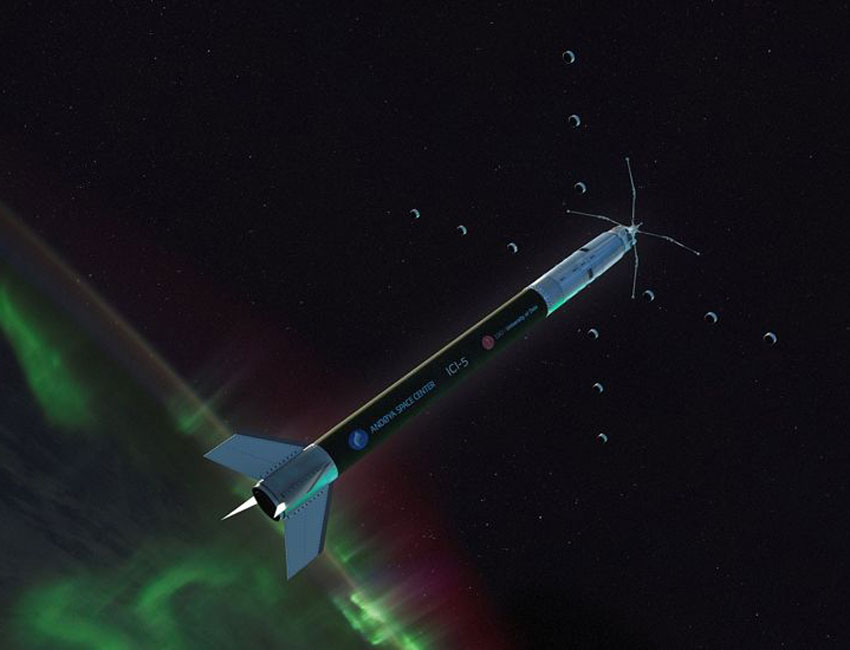Svalbard at the centre of a giant rocket project

Top image: “Cusp” is an opening in the Earth’s magnetic field where energy and particles from the solar wind descend into the earth’s atmosphere. Every morning, Svalbard is just below the cusp. The researchers refer to the daytime aurora as “cusp” light. (Illustration: Trond Abrahamsen (Andøya Space Center).
UNIS and UiO want to find answers to a number of questions related to the energy transport through the polar atmosphere. In a giant research project, the “Grand Challenge Initiative – Cusp” (GCI-Cusp) with twelve rocket launches, researchers aim to solve some of the puzzles.
22 February 2019
Text: Jøran Moen, UNIS adjunct professor in upper polar atmosphere/University of Oslo
The “Grand Challenge Initiative – Cusp” (GCI-Cusp) is a giant rocket project with twelve rockets. The initiative was taken by the University of Oslo and Andøya Space Center. In earlier rocket campaigns, we have fired one and one rocket. This has not provided enough information to close forty-year-old science issues.
Our strategy is to combine multiple rockets into an observation system, share data and engage as many researchers as possible. The United States contributes with ten rockets, Norway and Japan with one rocket each. The rockets are launched from both Andøya and Svalbard in the winter of 2018/19 and 2019/2020.
What is a Cusp?
“Cusp” is a funnel in the earth’s magnetic field where the solar wind connects to the earth’s atmosphere. There is a “cusp” in the northern hemisphere and a “cusp” in the southern hemisphere (see top image). The solar wind is a gas of electrically charged particles that also draws magnetic fields from the sun. When the solar wind hits the earth’s magnetic field it connects and transmits large amounts of energy to the Earth’s atmosphere. The electric particles in the solar wind produce northern lights when they collide with the air gases. Temperature increases of several thousand degrees Celsius are common around the northern lights, at altitudes above 200 km. In the northern hemisphere, Svalbard lies under the “cusp” about 4 hours each day, between 08-12 local time. Through the polar night, in December and January, the “cusp” manifests itself in the daytime aurora.
Why Norway and Svalbard?
The answer is: “Location – location – location”. Svalbard is the world’s observation platform for daytime aurora. Therefore, large investments have been made in the EISCAT Svalbard Radar, the Kjell Henriksen Observatory, and Svalrak in Ny-Ålesund. Space research is one of the few subject areas where Norway can offer excellent locations. Therefore, much has been invested for a long time, and Norway can coordinate large international research projects.
Research questions
We want to find answers to a number of questions related to the energy transport in the polar atmosphere:
1) Explore dynamic variations in the link to the solar wind
2) Understand the processes of oxygen degassing, into space
3) Wave particle acceleration in the earth’s magnetic field
4) Pioneering studies of turbulence in the northern lights
These are fundamental issues that are important in understanding how planetary atmospheres are affected by the solar wind, not just the earth. The research is also of practical use for developing space weather warnings. For example, the knowledge we are looking for is absolutely necessary to be able to alert disruptions to GPS satellite signals in the High North.
SIOS – Svalbard Integrated Arctic Earth Observing System
The Norwegian rocket ICI-5 is financed through the Norwegian Space Center and the Research Council of Norway, as part of the national infrastructure project SIOS InfraNor. It will release 12 small “daughters” to measure turbulence structures in the northern lights (see image) in the altitude range 200-400 km above the ground. In 2017, UiO, SIOS, JAXA and NASA signed an agreement that GCI-Cusp shall share data through the SIOS database system. This database will contribute to the international research interest for Svalbard and we can reap even more knowledge out of the investments.
Status
Before Christmas 2018, NASA shot up four rockets; VISIONS-2 from Ny-Ålesund on December 7 and and TRICE-2 from Andøya over Svalbard on December 8. CAPER-2 was shot on January 4 2019. The student rocket G-CHASER is now being prepared for launch from Andøya. All the rocket launches so far have been successful and hit the northern lights we have been aiming for. This is thanks to the efforts of the universities in Bergen, Oslo and UNIS, who specialize in predicting the optimal launching time, so that the rockets will fly through active northern lights. Analysis of the VISIONS-2 data has already started and we are planning to enter the first data into the SIOS database in June 2019.
